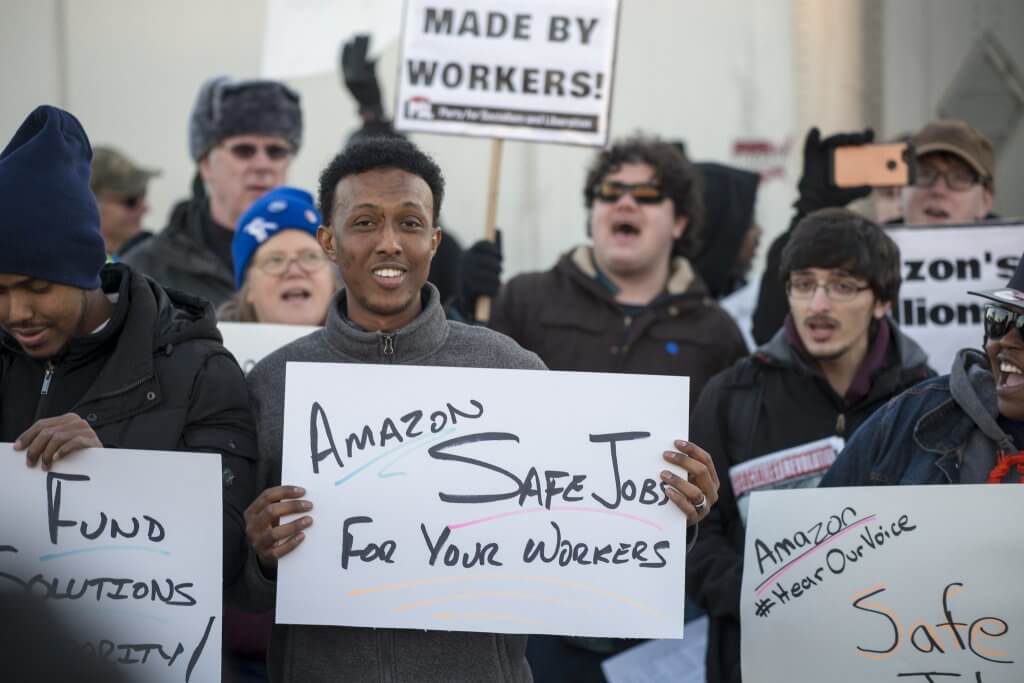Workers Concerned About Safety During Reopening
As many are called back to work, there are more questions than answers about their safety.

Workers at Amazon protest unsafe working conditions in Shakopee, Minn., in December 2018. The COVID-19 pandemic has increased concerns about job health and safety as employees are being called back to work. Photo by Fibonacci Blue. (CC BY-2.0).
The phone calls and emails have been coming in steadily for Jim Schultz since COVID-19 hit Wisconsin.
First they came when businesses across the state were told to cease operations — but others, deemed essential, were allowed to continue running and to observe physical distancing to keep people at least six feet apart to avoid spreading the disease.
Now they’re coming as businesses, no longer bound by the state’s defunct Safer at Home order, open up and call laid-off and furloughed employees back to work.
“I’m hearing from workers in meatpacking facilities, I’m hearing from construction workers,” says Schultz, secretary treasurer of WisCOSH — the Wisconsin Committee on Occupational Safety and Health, a job-safety advocacy group. Questions come from people working for large employers, union and nonunion alike, and small ones.
“Many of them, they don’t know now what to do,” says Schultz. “They’re scared.”
But in most of the state, local governments are permitting employers to open up with few if any requirements to ensure employees’ health and safety. Workers who have been laid off and collecting unemployment could lose their jobless pay if their employers call them back to work and they decline. Consequently, many workers are likely to face a difficult choice between making a living or ensuring their health.
“In an employment-at-will world, where there is no ‘good cause’ or ‘reasonable cause’ protections [from firing] for employees, especially private-sector employees, they really don’t have that much ability to fight against it,” says Paul Secunda, a lawyer with the labor and employment law firm of Walcheske & Luzi in Brookfield.
Representatives of employers display a more optimistic view of the pandemic-era workplace.
At a state Senate hearing Wednesday about Wisconsin’s unemployment claims backlog, a Wisconsin Manufacturers & Commerce lobbyist offered as one solution getting more workers back on the job swiftly.
“We need to lower the caseload,” said Scott Manley, WMC’s executive vice president for government relations. “We know that we can do that safely. Wisconsin employers are committed to doing so safely. They’re committed to taking the steps that are necessary to protecting the safety of their workers and the well-being of their workers and of their customers.”
But worker advocates say that there are plenty of bad examples contradicting such assertions. “There’s been a lot of concern from workers about not getting any personal protective equipment [PPE] or wondering if they’ve got the right kind,” says Schultz.
Unemployment compensation rules
The day after the state Supreme Court ruling that ended the Safer at Home order, the Department of Workforce Development (DWD) posted a web page explaining what a callback to work means for someone who has been laid off and is collecting unemployment.
“If people do choose not to return to work, we would consider that a work refusal, and we need to look at the law to determine whether or not a person would be eligible for unemployment benefits,” says Emily Savard, a DWD policy analyst.
If an employee’s only reason not to return to work would be their fear of illness, “typically they would not be eligible,” she says. But that scenario, Savard adds, points to the importance of keeping lines of communication open. “If somebody is feeling uncomfortable about returning to work, they should be talking to their employer about it.”
“The facts of the circumstance are important,” states the DWD’s return-to-work page. “An investigation would be conducted to determine if you would still be eligible.”
Wisconsin unemployment law includes a provision that quitting or refusing a job for good cause could make a person eligible for unemployment benefits.
“That good cause has to be attributable to the employer,” says Secunda. “There has to be a valid, substantial reason to not return for which the employer is responsible.”
A doctor’s prescription that the worker would be unsafe on the job because of risk for COVID-19 and needs to stay home and self-quarantine might qualify, depending on the details.
“DWD would need to examine the reasonableness of the objection to the job,” the department’s web page states. “Was the employer made aware of the objections and, if so, were there accommodations the employer could make to make the job safe?”
OSHA investigations
When it comes to actually assessing job safety, though, the state defers to the federal Occupational Safety and Health Administration (OSHA).
“There is a right under OSHA to not have to go back to work if you believe it is unsafe,” says Secunda.
Federal law obliges employers to provide a safe workplace. But, he adds, there’s a drawback: Individuals don’t have a private right to sue an employer for violating federal health and safety regulations that OSHA enforces.
“All you can do is report your claim to OSHA,” Secunda says. “You file a complaint with OSHA and then OSHA investigates it.”
A worker might also be able to file a complaint with the federal Equal Employment Opportunity Commission (EEOC) under the Americans with Disabilities Act (ADA), but would face similar hurdles, he adds.
Moreover, since taking office President Donald Trump’s administration has been cutting back regulations, including those that pertain to worker health and safety.
On Thursday, Sen. Tammy Baldwin (D-Wis.) and five Senate colleagues sent a letter seeking an audit by the U.S. Labor Department’s inspector general of OSHA’s handling of inspections and citations during the COVID-19 pandemic. The letter also seeks an investigation of the Labor Department’s failure to issue an OSHA emergency temporary standard on the pandemic’s risk to frontline workers.
“There is no evidence that employers are sufficiently protecting workers — in fact, there is an abundance of evidence to the contrary,” the letter states. “State and local governments have had to close essential businesses after they have failed to prevent and mitigate coronavirus outbreaks among employees.”
Baldwin and Sen. Tammy Duckworth (D-Ill.) have introduced legislation to require OSHA to issue a standard requiring all workplaces to implement comprehensive infectious disease exposure control plans during the pandemic.
Safety self-help
For workers trying to ensure their own safety, several organizations offer resources.
The BlueGreen Alliance — a partnership of labor unions and environmental groups — Thursday rolled out an online SafeJobChecklist for workers to compare what their employers provide in the way of health and safety measures as they return when the pandemic is still active: Adequate PPE; time and facilities to adequately wash hands; work stations that allow 6 feet or more of distance between people; sufficient cleaning and disinfection in the workplace; wellness rules that keep people home with pay if they’re sick, or send them home if they get sick; and the ability to speak up about safety on the job.
The website encourages workers to report their employers who fall short on the checklist and allows them to do so anonymously.
The national affiliate of WisCOSH, NationalCOSH, has published “A Safe and Just Return to Work” that similarly offers worker-centered guidance tailored to government policymakers.
When workers contact WisCOSH, Schultz and colleagues counsel them on their legal protections.
“We try to let them know what their rights are,” says Schultz. “Under the federal Occupational Safety and Health Act, you have a right to work in a place free from recognized hazards.” At the same time, he acknowledges that the law as written has made enforcement difficult and that the agency continues to be understaffed.
But workers do have other rights that they can and should use, he says.
“One of the best things they can do if they don’t have one is to form a health and safety committee in their workplace,” Schultz says. “Whether or not they have a union, they have a right to do that. And a right to talk about their concerns.”
Schultz recommends they keep detailed notes on the safety problems they encounter, and that they save all documents, flyers and memos the employer distributes and take them home for safekeeping.
If employers are distributing PPE, he adds, make sure the equipment fits every worker properly. WisCOSH has begun offering webinars that workers and employers can take to learn about COVID-19 and proper protection, including sanitation, handwashing and the proper disposal of contaminated PPE. The committee offers information on its website and its Facebook page.
Even if OSHA is slow to act, Schultz says, prosecutors — including the Milwaukee District Attorney’s office — have been known to prosecute employers in instances where egregious hazards to workers have led to death or injury.
He recommends that workers who are organizing for safety band together, not just work alone. “You need at least one more worker to stand with you and say, ‘We need you to provide personal protective equipment, and we shouldn’t be buying it out of our pocket,’” he says.
Schultz adds: “We try to keep to what they can do right now to protect themselves and give themselves and their coworkers peace of mind.”
Reprinted with permission of Wisconsin Examiner.
More about the Coronavirus Pandemic
- Governors Tony Evers, JB Pritzker, Tim Walz, and Gretchen Whitmer Issue a Joint Statement Concerning Reports that Donald Trump Gave Russian Dictator Putin American COVID-19 Supplies - Gov. Tony Evers - Oct 11th, 2024
- MHD Release: Milwaukee Health Department Launches COVID-19 Wastewater Testing Dashboard - City of Milwaukee Health Department - Jan 23rd, 2024
- Milwaukee County Announces New Policies Related to COVID-19 Pandemic - David Crowley - May 9th, 2023
- DHS Details End of Emergency COVID-19 Response - Wisconsin Department of Health Services - Apr 26th, 2023
- Milwaukee Health Department Announces Upcoming Changes to COVID-19 Services - City of Milwaukee Health Department - Mar 17th, 2023
- Fitzgerald Applauds Passage of COVID-19 Origin Act - U.S. Rep. Scott Fitzgerald - Mar 10th, 2023
- DHS Expands Free COVID-19 Testing Program - Wisconsin Department of Health Services - Feb 10th, 2023
- MKE County: COVID-19 Hospitalizations Rising - Graham Kilmer - Jan 16th, 2023
- Not Enough Getting Bivalent Booster Shots, State Health Officials Warn - Gaby Vinick - Dec 26th, 2022
- Nearly All Wisconsinites Age 6 Months and Older Now Eligible for Updated COVID-19 Vaccine - Wisconsin Department of Health Services - Dec 15th, 2022
Read more about Coronavirus Pandemic here





















